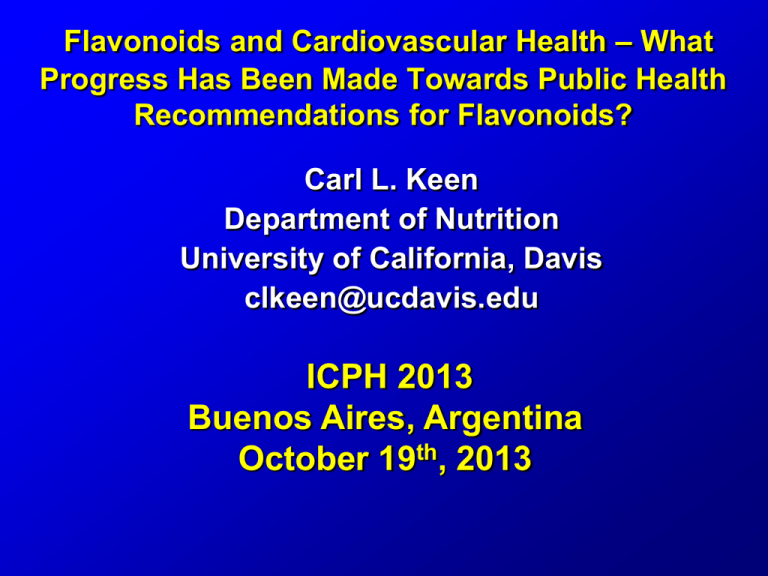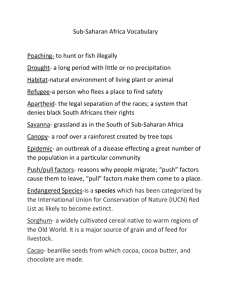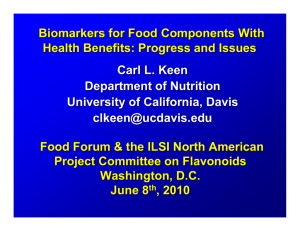Cocoa
advertisement

Flavonoids and Cardiovascular Health – What Progress Has Been Made Towards Public Health Recommendations for Flavonoids? Carl L. Keen Department of Nutrition University of California, Davis clkeen@ucdavis.edu ICPH 2013 Buenos Aires, Argentina October 19th, 2013 Disclosures for: Carl L. Keen AFFILIATION/FINANCIAL INTERESTS CORPORATE ORGANIZATION Grants/Research Support: Research Support From Mars Incorporated; California Walnut Board & California Strawberry Board Scientific Advisory Board/Consultant: Mars/Waltham Scientific Advisory Boards McCormick Spice Advisory Board Speakers Bureau: None Stock Shareholder: None Other Financial or Material Support/Honorarium: None Why address this issue? Accepted Fact: Diets rich in plant foods are associated with an overall positive health status and a decreased risk for certain diseases (e.g. vascular disease, certain cancers) Fruits, vegetables and CHD “ There are very few studies to date examining provision of, or advice to increase the consumption of, fruits and vegetables in the absence of additional dietary advice or other lifestyle interventions for the primary prevention of CVD. The limited evidence suggests advice to increase fruit and vegetables as a single has favorable effects on CVD risk factors but more trials are needed to confirm this.” Hartley et al., The Cochrane Collaboration, 2013. (similar points made in Dauchet et al. Nat Rev Cardiol. 2009) The inverse association seen between the consumption of plant food-rich diets and the risk for CVD is due to multiple nutritional variables: favourable sodium/potassium profile low in saturated fat high essential nutrient content high fibre content high in select “non-essential” phytochemicals Flavonoid Intake and Risk of CHD Mortality – Seven Countries Study Limited Analysis: Two Classes: • Flavonol quercetin kaempferol myricetin • Flavone luteolin apigenin Hertog et al. Arch Intern Med 1995; 155: 381-6 Flavanols & Vascular Health Speculation: The inverse association often reported between the consumption of plant food-rich diets and the risk for CVD is due to numerous factors including flavonoid-induced changes in: oxidant production and defence; the immune system; platelet reactivity, vascular reactivity, tissue repair and blood pressure. Biomarkers are needed for the assessing an individuals status for the phytochemical(s) in question, as well as for following the acute, and chronic impact of these phytochemicals on select health parameters Evaluation of Biomarkers 2010The Biomarker Evaluation Process Recommendations Recommendation 3: The FDA should use the same degree of scientific rigor for evaluation of biomarkers across regulatory areas, whether they are proposed for use in the arenas of drugs, medical devices, biologics, or foods and dietary supplements. Recommendation 4: The FDA should take into account a nutrient’s or food’s source as well as any modifying effects of the food or supplement that serves as the delivery vehicle and the dietary patterns associated with consumption of the nutrient or food when reviewing health related label claims and the safety of food and supplements. Recommendation 5b: Congress should grant the FDA authority to request studies and sufficient authority to act on the results of studies on consumer understanding of claims on foods and supplements. Evaluation of Biomarkers and Surrogate Endpoints in Chronic Disease; IOM, 2010 Evaluation of Biomarkers 2010Case Studies Evaluation of Biomarkers and Surrogate Endpoints in Chronic Disease; IOM, 2010 Consumption of Flavanol-containing Beverage Products - Uptake of Flavanols into the Circulation- 6 hours 2 hours 1 hours 0 hours Epicatechin Response (nA) 300 200 Catechin 100 0 Blood Plasma Flavanols/Metabolites after eating a high-flavanol cocoa product Circulating Flavanols/Metabolites [nM] 3000 epicatechin catechin 4'MEC EC-7Gluc 4'MEC-Gluc Sum 2500 2000 1500 1000 500 250 0 -1 0 1 2 3 4 5 6 7 time [h] Schroeter et al. PNAS 103:1024-29,2006 It is unlikely that the antioxidant properties of the flavanols being studied trigger the observed reduction in platelet reactivity Human Plasma [ORAC] 2.5e+5 Flavanol Metabolites (−)-epicatechin 3.7 (+)-catechin 15 Procyanidin Dimer B2 0.7 O-methyl-epicatechin 7.5 Epicatechin-glucuronide 9.4 Trolox equivalent [mol/L] Flavanol Metabolites Mixture Profile % of Total 2.0e+5 * 1.5e+5 Range of Dietary Relevance 1.0e+5 * 5.0e+4 O-methyl-epicatechin-glucuronide 63.7 0.0 0.01 0.1 1 10 [mol/L] 100 1000 10000 Acceptable Biomarkers – Antioxidant activity? Like Aspirin, CF (897 mg total flavonoids) can influence blood clotting (PFA-100) times in healthy adults Closure Time (s) Cocoa Aspirin 200 * * 150 Aspirin + Cocoa * * * Epi-collagen 100 50 0 0 2 0 6 2 0 Aspirin Cocoa 140 120 120 100 100 100 80 80 80 60 60 60 40 40 40 20 20 20 * 120 0 0 2 6 0 0 2 2 6 Aspirin + Cocoa 140 140 Closure Time (s) 6 6 0 * 0 2 * ADP-collagen 6 Time (hr) Pearson et al. Thromb Res 2002; 106: 191-7 Effects of Flavanols and Flavanol-Rich Food Consumption on Platelet Function Reference Type Dose Duration Subjects n Platelet Test Pace-Asciak ‘96 Red wine White wine Purple grape juice 375 ml/day 375 ml/day 500 ml/day 4 wks Healthy adults 24 Aggregation -- Aggregation Aggregation Duffy ‘01 Black Tea 900 ml/day 4 wks CAD patients 49 -- Aggregation Freedman ‘01 Purple grape juice 7 ml/kg/day 2 wks Healthy adults 20 Aggregation Rein ‘00 Cocoa beverage 1 dose Healthy adults 10 Platelet Reactivity Heptinstall ‘06 Cocoa Beverage 600-900 mg 1 dose Healthy adults 12 Flammmer ‘07 Chocolate 40 g 1 dose Heart transplant Hamed ‘08 Chocolate 100 g / day 1 week Healthy adults 28 Erlund ’08 “Berries” 100 g 8 wks Health Adults 72 Ostertag ’10 Cocoa/Chocolate “Moderate amount” Acute Meta Analysis 10 Studies Carnevale ’12 Chocolate 40 g 1 dose Healthy Adults Smokers 40 Isoprostanes, NOX2 300 mg Acute Healthy Adults 42 Platelet Reactivity Ostertag ‘13 Chocolate 300 ml Collagen stimulated Platelet Aggregation Platelet adhesion Platelet Reactivity Platelet Reactivity Platelet Reactivity Acceptable Biomarkers - Platelet Function ? Water-soluble tomato concentrate (WSTC I and II) and platelet aggregation. Scientific substantiation of a health claim related to water-soluble tomato concentrate (WSTC I and II) and platelet aggregation pursuant to Article 13(5) of Regulation (EC) No 1924/2006. The EFSA Journal (2009) 1101, 1-15. Scientific opinion on the modification of the authorization of a health claim related to water-soluble tomato concentrate and helps to maintain a healthy blood flow and benefits circulation pursuant to Article 13(5) of Regulation (EC) No 1924/2006 following a request in accordance with Article 19 of the Regulation (EC) No 1924/2006. The EFSA Journal (2010) 8(7), 1689. Vascular Endpoints - FMD/PAT Ischemia (arterial occlusion) Hyperemia (transient increase in organ blood flow) Shear Stress (arterial occlusion) NO-Production (endothelial cells) Arterial Dilation (relaxation of smooth muscle) FMD – Nitric Oxide – Flavanol/Metabolites Cocoa-mediated increases in FMD are inhibited by L-NMMA infusion and NOS inhibition b 12 4 *# 6 *# *# *# 4 2 3 Increase RXNO (nM) Flow-mediated dilation (%) 10 8 c 2 0 *# 3,000 *# 1 # 0 -1 * * 2,500 *# *# 2,000 1,500 1,000 *# *# *# 500 * -2 0 1 2 3 4 5 6 hFCD lFCD 3,500 Sum of plasma flavanols (nM) a 0 0 1 2 3 4 5 6 * ** 0 1 2 3 4 5 6 Time after cocoa drink (h) Schroeter et al. PNAS 2006 Epicatechin - FMD b d 10 *# *# PAT index 3 * * * 2 1 Water 1 mg/kg Epicatechin 0 Flow-mediated dilation (%) 4 *# 8 6 4 2 Water 1 mg/kg Epicatechin 0 0 0 1 2 3 *# 4 1 2 3 4 Time after Ingestion (h) Time after Ingestion (h) Schroeter et al. PNAS 103:1024-29,2006 Effects of Flavanols and Flavanol-Rich Food Consumption on Vascular Function Reference Type Dose Duration Subjects n 11 Vascular Response ↑FMD, RXNO Heiss 2005 Cocoa 88 -370 mg 1-day Smokers Schroeter 2006 Cocoa 917 mg 1-day Healthy Adults 16 ↑FMD, RHI, RXNO Heiss 2007 Cocoa 918 mg 1-week Smokers 11 ↑FMD Balzer 2008 Cocoa 963 mg 30-days Diabetics 41 ↑FMD Heiss 2010 Cocoa 375 mg 30-days CAD patients 16 ↑FMD, CAC, Nitrite Monohan 2011 Cocoa 69 – 1095 mg 1-day Older Healthy Adults 23 ↑FMD Loffredo 2012 Chocolate 40 g 1-day Smokers 40 Healthy Adults ↑FMD, ↓NOX2 Nogueira 2012 Chocolate 50 g 4 wks Hypertensive 20 ↑RHI Mellor 2013 Chocolate 13.5 g 1-day Diabetics 10 ↑RHI How Does FMD/PAT Compare to Blood Pressure as An Accepted Marker? • Predictive value of noninvasively determined endothelial dysfunction for long-term cardiovascular events and restenosis in patients undergoing coronary stent implantation: a prospective study. Akcakoyun M, et. al. Coron Artery Dis, 2008; 19:337-343 • Persistent impairment of endothelial vasomotor function has a negative impact on outcome in patients with coronary artery disease. Kitta Y, et. al., J Am Coll Cardiol 2009;53:323-30 Rubinshtein, R et al. Eur Heart J 31:1142-8, 2010 Acceptable Biomarkers - FMD? Scientific Opinion on the substantiation of a health related to cocoa flavanols and maintenance of normal endothelium-dependent vasodilation pursuant to article 13(5) of regulation (EC) No 1924/2006. The EFSA Journal (2012) 10(7), 2809. Scientific opinion on the substantiation of a health claim related to vitamin K2 and contribution to the normal function of the heart and blood vessels (ID 125, further assessment) pursuant to Article 13(1) of Regulation (EC) No 1924/2006. The EFSA Journal (2012) 10(6), 2714. Effects of Flavanols and Flavanol-Rich Food Consumption on Blood Pressure Reference Type Dose Grassi 2005 Chocolate ~ 500 mg 2 wks Healthy adults 15 ↓ Systolic Taubert 2007 Chocolate 30 mg /day 18 wks Pre Stage 1 hypertensive 44 ↓ Systolic, Diastolic Davison 2008 Cocoa 902 mg 12 wks Overweight/ Obese 49 ↓ Diastolic, MAP Balzer 2008 Cocoa 960 mg 30 dys Medicated Diabetics 41 No Change Manuiyappa 08 Cocoa ~ 900 mg 2 wk Hypertensive 20 No Change Shiina 2009 Chocolate 550 mg 2 wks Healthy Adults 39 No Change Davison 2010 Cocoa 33, 372, 712, 1052 mg /day 6 wks Hypertensive 52 45, 520, 990 mg /day 8 wks 416 mg 4 wks Desideri 2012 Sarria 2013 Cocoa Cocoa Duration Subjects n Blood Pressure ↓ 24 hr ambulatory SBP, DBP, MAP at high flavanol intake Cognitively Impaired 90 Healthy Adults 44 ↓ Systolic, Diastolic (520 and 990 mg) No Change Fruit and Vegetable Intake in Childhood is Inversely Associated with Pulse Wave Velocity in Adulthood Vegetable consumption in childhood inversely associated with Adulthood PWV (p = 0.02) Persistently high consumption of both fruits and vegetables from childhood To adulthood was also associated with a lower PWV. ↑ PWV = ↑ Arterial Stiffness Aatola et al, Circulation 122:2521-8, 2010 Acceptable Biomarkers - Arterial Stiffness? Evolus® and reduce arterial stiffness. Scientific substantiation of a health to Lacotbacillus helveticus fermented Evolus® low-fat milk products and reduction of arterial stiffness pursuant to Article 14 of the Regulation (EC) No 1924/2006. The EFSA Journal (2009) 1101, 1-15. Statement on the safety of the “conjugated linoleic acid (CLA)-rich oils” Clarinol® and Tonalin® TG 80 as Novel Food ingredients. The EFSA Journal (2012) 10(5), 2700. New Biomarkers - circulating EPC levels? CAD patients (n=519) with Highest Medium Lowest numbers of EPCs. Werner et al., NEJM, 2005 Circulating Endothelial Progenitor Cells, Vascular Function, and Cardiovascular Risk Hill, JM et al. NEJM 348:593-600, 2003 CF effects in medicated CAD Patients • n=16 • medicated CAD patients Readouts Time (days) FMD CAC BP NOx Control Control 9 mg of flavanols twice a day 9 mg of flavanols twice a day Treatment 375 mg of flavanols twice a day Treatment 375 mg of flavanols twice a day 30 1 Wash-out 1 30 Day 1 Day 30 Day 1 Day 30 + + + + + + + + + + + + + + + + Heiss et al., JACC, 2010 CF Has Vascular Effects in CAD Patients *# a 1.5 CD34 /KDR (%MNC) * 0 b 1.0 * 0.5 0.0 b 140 130 *# + *# 1.0 120 0.5 + Systolic BP (mmHg) *# + 5 + FMD (%) 10 CD133 /KDR (%MNC) a 20 10 0 pre post pre C FI Heiss et al., JACC, 2010 post *# 0.0 pre post C pre post FI Contribution of 30 Biomarkers to 10-Year Cardiovascular Risk Estimation in 2 Population Cohorts: The MONICA, Risk, Genetics, Archiving, and Monograph (MORGAM) Biomarker Project Blackenberg, S et al. Circulation 121:2388-97, 2010 Conclusions/Summary: The results obtained from numerous intervention trials support the concept that the consumption of flavanol-rich foods can result in acute (1 – 30 days) improvements in vascular health parameters that are suggestive of a decreased risk for select chronic diseases. Conclusions/Summary: With respect to dietary recommendations for “flavonoids”, the emphasis should be on defined members of the class, rather than the entire class Conclusions/Summary: When considering the development of biomarkers for following the effects of a food or a non-essential nutrient on the risk for select diseases, there may be value in aiming for a model that takes into consideration the effects of the food/nutrient on multiple risk factors for the disease of interest.





